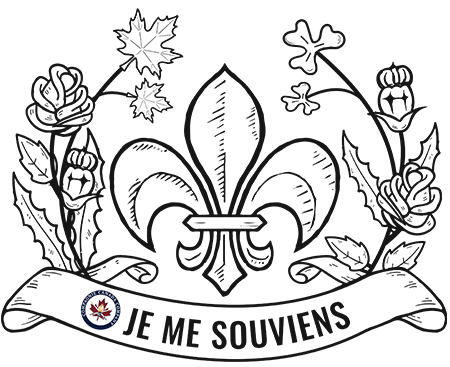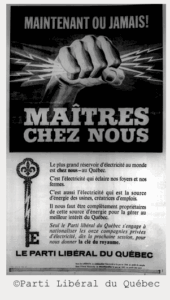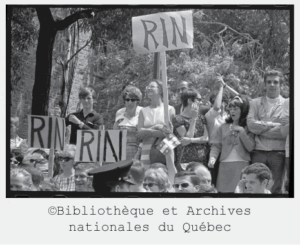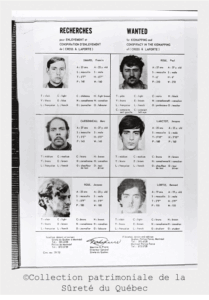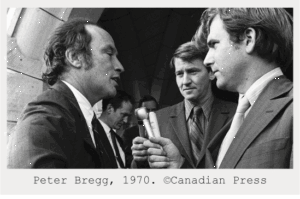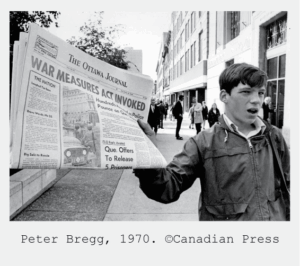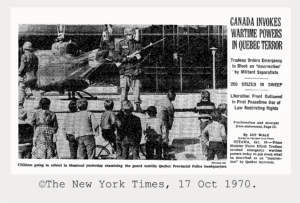A World in Turmoil
From Quiet Revolution to Armed Revolution
Psst, you can turn on English subtitles in the video settings!
The Quiet Revolution
After many years under Duplessis’s harsh Conservative regime, Quebec society went through an awakening in the 1960s. Quebec gradually began to adhere to the principle of the welfare state when the government nationalized Hydro-Québec and withdrew the Catholic Church’s powers over the education and health care systems. The Montreal metro system, Expo ‘67 and the Manic-5 dam showed that Quebec could carry out large-scale projects and take its place on the world stage.
Labour Conditions
After years of anti-union government, some saw a golden opportunity to strengthen workers’ rights. The main unions supported their members during many demonstrations, as the Front de libération du taxi did for taxi drivers. Lapalme postal workers had a major conflict with the Trudeau government. The unions wanted to completely reform society, which meant that the union leaders at the time found themselves unintentionally caught up in the October Crisis.
Rise of Nationalism
The Rassemblement pour l’indépendance nationale (RIN; Rally for National Independence) was founded in 1960. In the global context of decolonization, the members of this movement dreamt of seeing Quebec become an independent state. In 1970, the government’s proposed Bill 63 created language tensions in a landscape that was already ripe for confrontation. The April 1970 provincial election was seen as a failure by ardent separatists, as the new Parti Québécois, which was founded by René Lévesque in 1968, elected only seven MNAs despite getting nearly a quarter of the vote. Some, like the FLQ, saw this as proof of democracy’s failings; for them, violence became the only path to liberation.
The FLQ
Founded in 1963, the Front de libération du Québec was a sovereigntist and Marxist-Leninist terrorist group. The movement was divided into cells and consisted of intellectuals and people from the working class. The FLQ took up social struggles to build a society that could meet the needs of Francophone workers, and its manifesto freely attacked the bourgeois and especially Anglophone class at the time. The FLQ targeted symbols of the federal government, such as the Canadian military. The movement was funded by bank heists and seemed to have had some public support in its early years. The organization set off bombs in factories that had been shut down in the months and years before the October Crisis as well as in mailboxes to symbolize their support for the Lapalme employees. As many of its members had been arrested as a result of their activities, the FLQ called for the release of these political prisoners in exchange for their hostages.
Quebec seen from Canada
In 1970, Canada was still a relatively young country. Canada had celebrated 100 years of Confederation in 1967, but it had only had its own standing army since 1914 and formal control of its own foreign policy since 1931. In 1970, it had only been five years since Canada had first hoisted its own flag, the Maple Leaf, without the British Union Jack on it. The growing call for independence in Quebec hung heavily over the heads of politicians in Ottawa, as it was a direct blow to national unity and would undo generations of nation-building.
In 1968, Pierre Elliott Trudeau, a staunch federalist, was elected Prime Minister. He rejected any mention of separatism and made Canadian unity a key part of his platform, making statements like “We will not let this country be divided, neither from within nor without.”
The War Measures Act
The War Measures Act that was invoked during the October Crisis was a law first written in 1914 in response to World War I. It grants the federal government a broad range of powers and allows the cabinet to bypass the House of Commons and Senate in order to maintain security during “war, invasion or insurrection, real or apprehended.” The War Measures Act also allows for a suspension of civil liberties, such as the right to a trial or freedom of the press, in the interest of security.
The War Measures Act was invoked during both world wars and was the legislation famously used to imprison thousands of civilians identified as “enemy aliens” in internment camps without trial. Opponents of the government could also be imprisoned for sedition, as was the case for Montreal mayor Camillien Houde, in 1940. In World War I, the War Measures Act also enabled federal troops to intervene in the anti-conscription riots of 1918 in Quebec City.
In 1960 the federal government wrote the Canadian Bill of Rights, which ensured Canadians the rights they had been denied during the world wars, such as the rights to “life, liberty, security of the person and enjoyment of property, and the right not to be deprived thereof except by due process of law.” A notwithstanding clause, however, meant that these rights could still be overturned by the War Measures Act, as was the case in 1970.
The Canadian Military – A Short History
Up until Confederation, the military presence in Canada was the British Army. When they withdrew, they were replaced by an often poorly trained and poorly funded volunteer militia. In 1914, an official army was created and proved itself on the international stage in both World War I and World War II, with impressive victories such as that at Vimy Ridge (1917) and the liberation of the Netherlands (1945). After the world wars, the Canadian Armed Forces gained a reputation as international peacekeepers.
But if the role of an army is usually to protect a nation during international conflict, what was the army doing in Quebec? The army, from its days as a militia to today, actually has a long history of intervening, at the request of a municipality, province or the federal government, in domestic affairs. In fact, the army was called to intervene in strikes, riots and elections over 50 times in Quebec alone from 1867 to 1970. The Canadian army has also played an important role in providing support to security forces, such as during the Olympics, and in disaster relief.
“In those days, the armed forces were very involved in supporting the police, which wasn’t as equipped as they are today with tactical groups. So we were the ones who performed this role. We used to do riot control and things we don’t do anymore.” Lcol (ret) Carol Mathieu
The 1960s and 1970s were a time of overwhelming social and political change around the world. Students, workers and peasants mobilized in dozens of countries, fighting for civil rights and marching against war, imperialism, capitalism and repressive political regimes. While many of these movements were relatively peaceful, some groups used violence, from guerilla warfare to kidnappings, to promote liberation from oppression, colonialism, and other political goals.
The world was also going through a rapid process of decolonization, with over 40 countries gaining independence in the 1960s alone. For many of these countries, independence was achieved by means of violent uprisings, protest and even outright war.
The FLQ was directly inspired by a number of these movements, with founders expressing open admiration for revolutionaries in Cuba, Algeria and Uruguay. Two members even trained with Palestinian Guerillas in Jordan.
World map showing a selection of student movements, independence movements and terrorist movements active from 1962 to 1970.
In green: selection of student protest movements.
In blue: conflict or war of independence.
In dark blue: terrorist movements.
